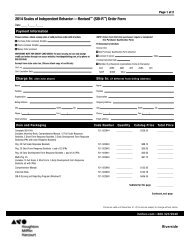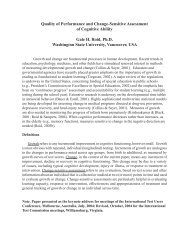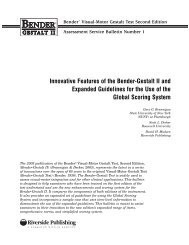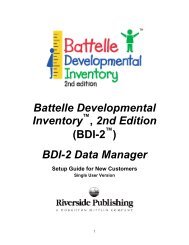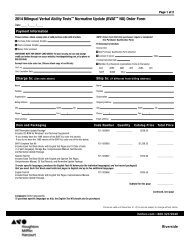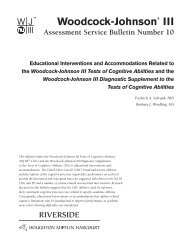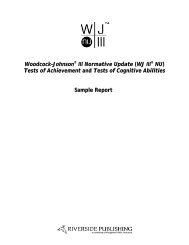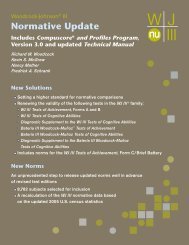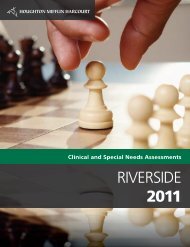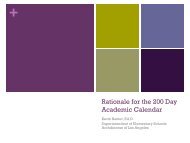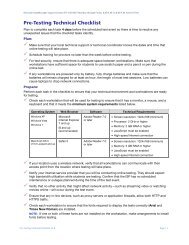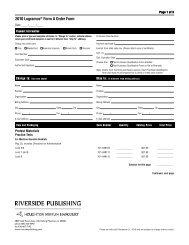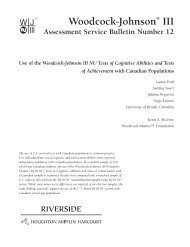User's Guide - Riverside Publishing
User's Guide - Riverside Publishing
User's Guide - Riverside Publishing
Create successful ePaper yourself
Turn your PDF publications into a flip-book with our unique Google optimized e-Paper software.
vv-t graphWhat can be said about displacement, velocity andacceleration at and between t 1and t 2?tt 1 t 2vv-t graphtt 1 t 2Phys211C2 p5Motion with constant accelerationa simplified model for many useful situationsa = a ava = constant means v-t graph is a straight linewith the conventions:velocity is v at time t,velocity is v 0at time 0 :v2− va av=t2− t1orv = v + at01v − v0→ a =t − 0Phys211C2 p6
materials. In some instances, the assessment maybe conducted by a team consisting of an Englishspeakingexaminer and a Spanish-speakingexaminer. Examiners will need the followingcomponents from the English BDI-2 test materials:■■■■■■Complete Manipulatives KitSet of Presentation CardsPuzzle/Strip Sheet componentsStudent WorkbookExaminer’s ManualMaterials from the BDI-2 Screening Test kit,including:■■■Screening Test Worksheet blacklinemasterScreening Test Presentation CardsScreening Test Stimulus BookTable 1 presents the major modifications of theBDI-2 Spanish materials. It is recommended thatexaminers pay particularly close attention to thesemodifications during administration.Printing and BindingThe BDI-2 Spanish materials are provided in anelectronic (CD-ROM) format. The CD-ROM containsall the files needed to create a full set of theSpanish materials. You will need to print andassemble these materials before you begin anyassessments. One reason the CD-ROM format wasused was to minimize expense for the customerand to use the benefits of modern technology inthe delivery of quality assessment tools. Anotheradvantageous reason for using electronic files isthat if an Item Test Book is lost or a page becomesdamaged, the lost or damaged piece can bereplaced without having to purchase a completelynew set of materials.Table 1Major Modifications of the BDI-2 Spanish MaterialsAdditional English TextNew StudentItem or Special Notes New Stimulus New Presentation Workbook BlacklineNumber a Added to the Item Book Page Created Cards Created Master CreatedRC 28■RC 29■RC 34RC 35■■RC 36■RC 37■RC 39EC 12EC 19EC 27EC 29 / ST 54■■■■■EC 34/ ST 58 ■ ■EC 36 ■ ■EC 37EC 40EC 44■PM 16 ■ ■PM 18 ■ ■RA 20 ■ ■ ■PC 28/ ST 97 ■ ■ ■a Abbreviations are as follows: RC=Receptive Communication; EC=Expressive Communication; ST=Screening Test; PM=Perceptual Motor; RA=Reasoning and Academic Skills;PC=Perception and Concepts.BDI-2 Spanish User’s <strong>Guide</strong> 3
If you have not already done so, you are stronglyencouraged to print and review the “Read Me” file(BDI2_Readme_File.pdf) provided with yourCD-ROM. This file consists of a brief letteridentifying the content of the other files on thedisk. It also includes suggestions for appropriateprinter and paper combinations for printing eachof the files. The instructions can help to createhigh-quality but inexpensive materials that aresimilar in look and feel to the English materials. Allthe printing can be generated from a color desktopprinter using standard-bond paper. A high-speed,two-sided laser printer is recommended for printingthe six Item Test Book files from the CD-ROM.Another widely available option is to take theCD-ROM to a local copying service and have thematerials printed and bound professionally.Major Steps of the Translation ProcessThe translation process for the BDI-2 underwentthree distinct stages, using three groups of mostlyindependent translators from numerous Spanishspeakingcountries. At each stage, the goal was toproduce a “consensus” translation that would besuitable for the broad group of Spanish-speakingcultures within the population of the United States.The initial translation stage began by using theitems from the BDI-2 English Tryout Edition toprovide a foundation for the instrument. The goalwas to establish a core set of Spanish text thatwas based on the Tryout items and to identifyitems that would be challenging either because ofthe differences between English and Spanishgrammar or idioms or because of cultural biases.This first effort was intended to be only a startingpoint, as numerous items would later be added ormodified for the Standardization items.During the standardization of the English BDI-2,the revised items were reviewed and translatedas needed by a different team of native Spanishspeakers. In this second stage, the process againmoved toward achieving a consensus translation,using the Standardization items as a new referencepoint. Aware that no major changes would be madeto the English items after the standardizationwas completed, the team knew it would have awell-polished set of administration instructionsthat would require only a final review before theSpanish version of the BDI-2 could be published.After the final set of items for the published Englishmaterials had been determined, translation forthe text that would be used for the Record Formsand the BDI-2 ScoringPro Software was begun.This third stage of the work focused on identificationof any remaining items that would require adaptationto the English items and translation of the finaltext of the BDI-2 developmental milestones. Thisfinal text was needed for inclusion in the scoringsoftware that would be sent to customers beforethe Spanish printed materials would be available.Shortly after the publication of the English BDI-2,production of the final Spanish materials began.The production process included implementationof minor changes from the English materials and afinal review of the translation for universality of thetext and faithfulness to the context and content ofthe items. The materials included on the CD-ROMare the culmination of this developmental process.Key Points Related to AdministrationAdministration of the BDI-2 in Spanish is nearlyidentical to administration of the English version.It is anticipated that the model most frequently usedfor administration will involve a bilingual examinerexperienced in assessment in both languages.Another model may use a team approach, in whichthe Spanish assessment is conducted by a nativeSpanish speaker in cooperation with, or under thesupervision of, an English-speaking examiner.Either option is acceptable for administration, butthe latter requires close, ongoing communicationbetween the two examiners to ensure consistencyof assessment procedures.It is important to remember that administrationof the BDI-2 Spanish materials can follow variouspaths, depending on the English proficiency of theparent(s) and the child. The simplest administrationmodel is one in which the full assessment is completedentirely in Spanish with both the parent(s) orcaregiver(s) and the child. This model is comparableto the standard administration, in which theEnglish materials are administered to a child andparent(s) or caregiver(s) who speak only Englishin the home.Another possible model is one in which the child’sEnglish-language skills are relatively strong as aresult of exposure to English-language radio andtelevision, positive English-language educationalopportunities, and interaction with older siblingswho primarily use English for communication. Inthis model, the child may complete all thestructured items of the BDI-2 in English and theparent(s) or caregiver(s) may be interviewed inSpanish (if that is more comfortable for them). Usingthis model, followed by the readministration inSpanish of any structured items the child missedin English, offers an opportunity to determine thechild’s maximum developmental level across both4 BDI-2 Spanish User’s <strong>Guide</strong>
languages and the extent to which a bilingualenvironment has either impeded or supported thechild’s communication and cognitive skills.Yet another possible scenario is one in which theparents are English speaking, but the child is not.This pattern often occurs in international adoptionor foster care situations. It is important to rememberthat the goal of any evaluation using the BDI-2 in anycombination of English and Spanish is to obtain acomprehensive picture of the child’s developmentalstrengths and opportunities for learning.ScoringThe procedures for scoring individual items of theBDI-2 Spanish version are identical to those of theEnglish BDI-2. For each item, the examiner scoresthe child’s performance as a 2- , 1- , or 0-pointresponse and indicates which procedure(Structured, Observation, or Interview) was usedto gather the item-level information. After theassessment is completed, raw scores for eachsubdomain may be calculated manually or withthe aid of the BDI-2 ScoringPro Software.Individuals who use the Palm-based ScoringAssistant software will find the various optionsfor administration in English or Spanish for theStructured, Observation, and Interview items agreat timesaver and organizer for all the materialsand for scoring. The Palm-based software uses anelectronic record form, which allows informationto be transferred directly to the ScoringProsoftware to complete the scoring and reportgenerationactivities.Numerous scores and scoring options are providedfor the BDI-2 Spanish materials. The first level ofscoring information provided is age equivalents.Age equivalents are based on data gathered fromthe English standardization sample of 2,500children from across the United States. Ageequivalentscores are the simplest scores tocalculate using the tables in Appendix A of theBDI-2 Examiner’s Manual (Newborg, 2005).Currently, no data are available on the ageequivalents for Spanish-speaking children, butthere is no reason to believe that there would beany significant differences between scores forHispanic/Latino and non-Hispanic/Latino children.The only area of possible concern may be theCommunication subdomains for children 5 yearsand older, in which several of the items weremodified to align the behavioral milestone withappropriate content for the two languages. Of the20 items presented in Table 1, 18 are Structuredonlyitems that require a spoken response from thechild for the most accurate score. At this time,there is no reason to believe that there would beany differences in scores between English andSpanish for items administered using theObservation/Interview administration procedures.Examiners who have administered the Spanishversion of the BDI-2 and who wish to calculateScaled Scores and Standard Scores using theEnglish BDI-2 Standardization norms are cautionedto do so only experimentally. Until examinersestablish local norms for their district or state, orthe publisher releases Spanish norms, an elementof uncertainty will surround the accuracy of thescores. As mentioned previously, the area thatpotentially may be most affected by the inherentdifferences between the two languages is theCommunication Domain. Anyone using theEnglish norms with the Spanish BDI-2 test data isadvised to consider the results to be experimental.Individuals and organizations interested in helpingto develop normative data related to the Spanishversion of the BDI-2 are asked to contact <strong>Riverside</strong><strong>Publishing</strong> via e-mail at rpcwebmaster@hmco.comor call 800.323.9540.Test-Retest ProcedureThe test-retest procedure holds great promise foranchoring the Spanish BDI-2 materials to theEnglish normative data. This procedure is similar tothe assessment procedure used for the BilingualVerbal Ability Tests (BVAT) (Muñoz-Sandoval,Cummins, Alvarado, & Ruef, 1998). For the BDI-2,assuming that the child and the parent(s) orcaregiver(s) speak very little English, the StructuredBDI-2 items are first administered to the child inEnglish, and a basal and ceiling are established foreach subdomain. All the Observation/Interviewitems are administered to the parent(s) orcaregiver(s) in Spanish, and there is no retestingon the interview items. Upon completion of theEnglish administration, any Structured itemhaving a score of 1 or 0 is readministered inSpanish and the new score is recorded.The evaluation continues in Spanish until the childachieves the ceiling level for each subdomain. Thebenefit of this procedure is that it allows the fullabilities of the child to be demonstrated. Thedifference between the English and Spanish rawscore totals for each subdomain can provide amore accurate picture of the role that languageplays in the child’s development and how muchmore help the child needs to achieve a high levelof English proficiency.Administration and Scoring 5
SummaryThe BDI-2 Spanish test materials provide asignificant opportunity to assess the developmentalstrengths and learning opportunities for theyoungest members of the Hispanic/Latinogroup—the largest and fastest-growing minoritygroup in the United States. The full potential ofthese materials will be realized when local and/ornational norms are established, and thepossibilities and rewards will be great.6 BDI-2 Spanish User’s <strong>Guide</strong>
ReferencesAmerican Educational Research Association (AERA), American Psychological Association (APA), &National Council on Measurement in Education (NCME). (1999). Standards for educational andpsychological testing. Washington, DC: AERA.Muñoz-Sandoval, A. F., Cummins, J., Alvarado, C. G., & Ruef, M. L. (1998). Bilingual Verbal AbilityTests. Itasca, IL: <strong>Riverside</strong> <strong>Publishing</strong>.Newborg, J. (2005). Battelle Developmental Inventory, 2nd Edition, Examiner’s Manual. Itasca, IL:<strong>Riverside</strong> <strong>Publishing</strong>.Ramirez, R. (2004, December). We the people: Hispanics in the United States, Census 2000 specialreports. Retrieved January 30, 2005, fromhttp://www.census.gov/population/www/cen2000/briefs.htmlU.S. Census Bureau. (2001). Census 2000 Summary File 1, United States. Washington, DC: U.S.Census Bureau.7
800.323.9540www.riversidepublishing.com



